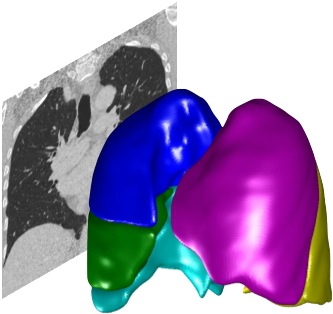Markers#
You can place markers on your image. Each marker is attached to a particular point in the image in 3D.
You might use a marker to indicate particular features in the image, for example reference points to be used in image registration. You could also use marker points to signify ground truth points, which can be used to evaluate an automatic segmentation.
Each marker has a label, which has an integer value between 1 and 255. These are presented with different colours on the screen. You might use a particular label to designate a particular feature. For simplicity, the GUI only allows you to set marker labels 1-7, but values up to 255 can be set programatically.
Showing markers in the PTK GUI#
Select the Markers tab to display markers and marker tools
The most recently used marker set for this dataset (if any exists) will be loaded and displayed.
If there is no existing marker set, click
+to create a new one. Or you can just place a new marker, which will automatically create a new marker set calledMarkerPoints(you can rename this later).
Marker Sets#
A Marker Set is a set of marker points. Only one set of markers is displayed at a time. The markers in the marker set may have different labels. For example, you could create a marker set to validate a fissure segmentation, by placing markers on each fissure. You can use different marker labels (colours) for each fissure, so all the markers are contained within the same marker set.
Any existing marker sets for this dataset are listed under Marker Sets:
Click on a marker set to load it
Click
+to create a new marker setRight-click on an existing marker set to show a menu to duplicate, rename or delete it
Adding markers#
Press the
+button to create a new marker set.Click on the image to place a marker point of the current colour. (NB. If you do not create a marker set, one will be created automatically with the name
MarkerSetwhen you place your first marker point).Press the marker colour button to change the label
To simplify use, markers of the same label (colour) cannot be placed too close to each other. If you click close to another marker, this will move that marker to this location. This makes it easier to refine marker locations.
Markers have a 3D location. Markers will only be shown for the current 2D image slice. As you cine through the volume, the markers for the current image slice will be shown.
Use the show/hide markers button to toggle display or markers on and off
Drag the marker to move it
Right click on a marker to bring up a menu to change the label or delete the marker
Use the label button to switch on or off display of coordinates for the markers in the image
Keyboard shortcuts#
Number keys
1,2etc. change the current marker label/colourLtoggles labels on or offThe delete key, when the mouse is hovering over a marker point, will delete that marker point
Changing between marker sets#
Click on a marker set to load that marker set. Only one set can be loaded at a time.
Changes are normally saved automatically
Right-click on a marker set to bring up a menu to delete, rename or duplicate a marker set
Export marker points to an XML file#
Use the
Export Markersbutton to save the current marker set to an XML file. The coordinates will be Dicom coordinates for this image
Accessing marker data using the API#
You can call the
LoadMarkerSetmethod on aPTKDatasetobject to get a structure containing the points data for the specified marker setMarkers are stored with dependency information, which means that plugins can depend on marker sets. If a plugin access marker set data, and the marker set is changed, the plugin will be re-run when necessary.
Markers in the PTKViewer mini-viewer#
The PTKViewer mini-viewer supports marker editing. To use this you need to programatically load the marker points into the
MarkerImageSourcewithin the MimViewerPanel. Marker mode is activated by the user clicking theMarkbutton on the PTKViewer
Technical details#
Each marker set is saved as a custom class in the
TDPulmonaryToolkit/Markersdirectory, under a subdirectory for the dataset UID.Saved marker set files are not guaranteed to be compatible between PTK versions.
